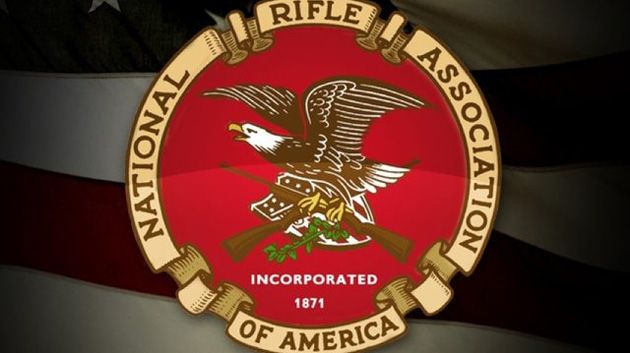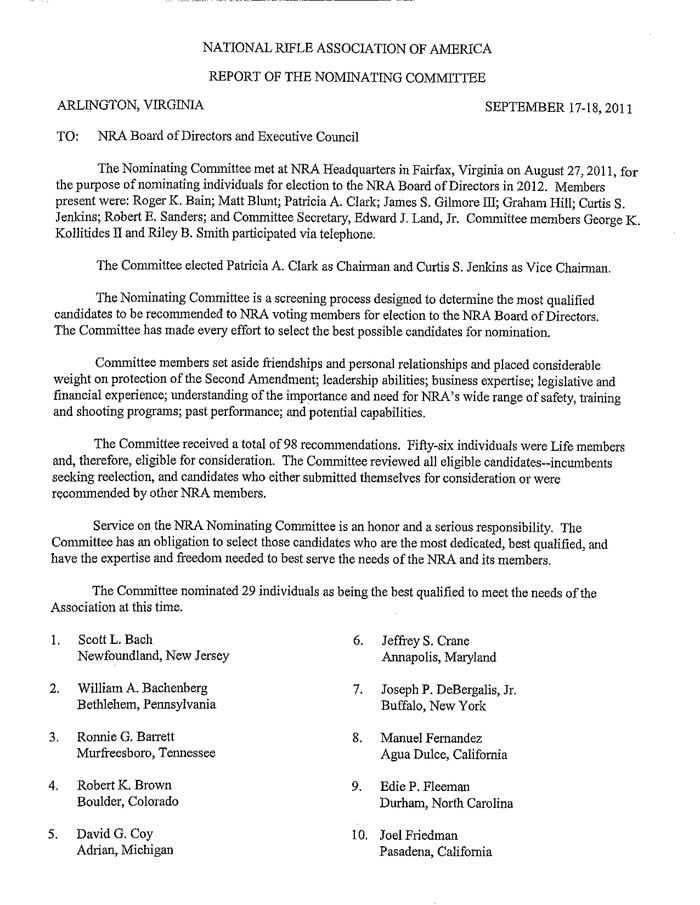Four Years after Sandy Hook, the NRA Continues the Arming of America
http://www.progressive.org/news/2016/12/189100/four-years-after-sandy-hook-nra-continues-arming-america
The weekend after the presidential election, I attended a gun show in Frederick County, one of the rural counties in the blue state of Maryland that voted for Donald Trump. One mother, with her infant resting quietly in a navy blue stroller, pulled back the black metal slide of a 9mm pistol. Not far away a man caressed the polymer handguard and stock of an AR-15 semi-automatic rifle.
The National Rifle Association manned a booth near the entrance. One of the men behind the green wooden counter, whose nametag read Bob, said he was a longtime NRA member. I asked him what he thought about NRA head Wayne LaPierre. “He’s well-spoken, and I trust him,” he answered.
Wayne LaPierre, in a video made by the NRA just days after the election, credited NRA members for Trump’s victory: “On November 8, you, the five million members of the National Rifle Association of America, along with the tens of millions of gun owners all over this country, who followed your lead, achieved a truly extraordinary, historic, even heroic accomplishment.”
The election of Donald J. Trump, combined with a Republican sweep of the Senate, has given today’s GOP an unprecendented monopoly of power. The NRA now finds itself within reach of goals that it has pursued for nearly forty years. The organization has arrived at this point via a combination of patience, self-control, and deceit.
“In the face of the bitter hatred and elitist condemnation, this is our historic moment to go on offense and defeat the forces that have allied against our freedom once and for all,” stated LaPierre in a recent video titled, “Our Time is Now.” With a patient, self-effacing demeanor, he’s the first executive director to not come from a military, hunting, or sports background.
In the video, LaPierre also mocks universal background checks, favored by 70 to 90 percent of Americans, and derides other “common sense” gun laws. He calls for the new Congress to pass a national concealed carry reciprocity law, which would require states to accept a concealed carry weapons permits issued by other states, much like the way states recognize each other’s driver licenses. Today, twenty-six states have at least some restrictions on who is eligible to carry a concealed weapon. Among them, nine states further limit such permits to people like security guards.
LaPierre also claims President Obama has “infected” federal courts with 300 constitutionally unsound judges and states that “Second Amendment freedoms” should trump state and municipal gun control laws. How is it that in Washington, D.C., one can now legally keep a gun in the home, asks LaPierre, but there is no place to buy a gun in the same city?
The NRA pumped a record $38 million into ads to help elect Donald Trump, and another $24 million to secure GOP control of the Senate. With the help of NRA campaign ads saturating the airwaves, six NRA-backed Senate candidates won key races, including Marco Rubio in Florida. Now the gun lobby is making an unprecedented push for federally mandated measures to expand the ability of state gun permit holders to carry firearms nationwide. The group is also seeking national legislation to legalize silencers. The NRA supports President-elect Trump promise to eliminate “gun-free zones” across the country, too.
“I don’t think it’s quite game over,” said Jonathan E. Lowy, legal director of the Brady Campaign to Prevent Gun Violence. “But there are reasons to be concerned.”
Trump will appoint at least one justice to replace the late Antonin Scalia, but the court’s liberal justices include Ruth Bader Ginsberg, who is eighty-three. If Trump gets to appoint a second Supreme Court justice, America’s entire political landscape could change. The NRA is looking for a Roberts court decision that would not only proscribe future attempts at gun control, but dramatically expand firearms access across the nation.
None of this was supposed to happen.
For years, many liberal pundits proclaimed the NRA was in decline. Gun ownership, they noted, has been decreasing across America. One report found that just three percent of Americans own most of the nation’s guns. The NRA, some said, is facing the same kind of challenges as the Republican Party in a nation that is increasingly diverse.
And then there was the gun tragedy that led gun reformists to believe their time had finally come. This Wednesday, December 14, marks the fourth anniversary of the slaughter of twenty small children and six of their educators at Sandy Hook Elementary School in Newtown, Connecticut. The Sandy Hook tragedy was preceded by many other mass shootings from Columbine to Aurora, from Tucson to Virginia Tech, to name just a few, not to mention the more mundane, daily toll of gun violence. But it was this unspeakable schoolhouse tragedy that finally seemed to signal a time for change.
“So our hearts are broken today—for the parents and grandparents, sisters and brothers of these little children, and for the families of the adults who were lost,” said a teary-eyed President Obama. Over the ensuing six months, there was a palpable hope that Congress would finally act. The Senate drafted bills to try and pass “universal” background checks, even though they still had large loopholes.
But even watered-down versions of the relatively token legislation failed due to the threat of a Republican filibuster over a Democratic-controlled Senate. None of the legislation introduced after Sandy Hook ever even made to the GOP-controlled House.
Understanding how the NRA survived Sandy Hook helps explain how the gun lobby has ended up on top today. It prevailed by downplaying its own extremism, and by presenting one alleged “independent” expert whose influence ran all the way to the Senate and Supreme Court.
LaPierre’s initial response to Sandy Hook shocked many people. “The only thing that stops a bad guy with a gun is with a good guy with a gun,” he said, adding that if any adults at Sandy Hook had been armed, the children and educators might still be alive. His comments were described as “tone-deaf.” During the subsequent Senate Judiciary Committee’s hearing on gun violence, Democratic Senator Dick Durbin of Illinois asked LaPierre if he thought the Second Amendment was meant to let citizens amass arms as a check on government, the driving mantra of gun rights absolutists. LaPierre said this was the Founding Fathers’ original intent, sidestepping the question of whether this is still the NRA’s view now.
Another witness at that Senate hearing, David Kopel, titled his testimony, “What Should America Do About Gun Violence?” He identified himself as the research director of the Independence Institute in Golden, Colorado, an associate policy analyst at the Cato Institute in Washington, D.C., and an adjunct professor of advanced constitutional law at Denver University. He did not disclose that his Institute had received more than $1.4 million, including about $175,000 a year over the past eight years, from the NRA Civil Rights Defense Fund. For decades, until the funding was uncovered first by this reporter at MSNBC.com and later by FOX31 in Denver, Kopel managed to write op-eds in leading newspapers including The New York Times, The Washington Post and The Wall Street Journal, without ever identifying his NRA funding.
Kopel also wrote law journal pieces at top schools, including Harvard, Yale, and the University of Michigan, without disclosing his NRA funding. And he appeared before the Supreme Court, as part of the team arguing in favor of gun rights in the District of Columbia vs. Heller. His amicus briefs on behalf of law enforcement groups, at least two of which have themselves received NRA funding, each failed to mention any NRA funding to either these groups or himself. Kopel’s briefs were cited four times in 2008 in Heller’s majority decision by the late Justice Antonin Scalia. They cropped up again in 2010 in another landmark Supreme Court gun case, McDonald v. Chicago.
Four years can seem like a long time. The gun reformists who were expecting victory after Sandy Hook now see their worst nightmares forming on the horizon.
It’s true that an NRA victory is hardly assured, especially at the state level. In November, gun restrictive referendums passed in three out of four states. In Washington, courts can now block access to people deemed dangerous. In California, background checks are now required to buy ammunition. Nevada voters passed one of the nation’s most restrictive laws, requiring background checks for almost any firearms transfers. A similar initiative failed in Maine.
“The [gun control] movement is in better shape than it’s ever been,” says Josh Sugarmann, executive director of the Violence Policy Center and longtime gun control expert, He points to relatively new organizations including one funded by parents who lost children at Sandy Hook, and another organized by former Arizona Rep. Gabby Giffords, who was injured in a racially motivated 2011 attack that killed six people, including a child. A third group organized by former New York Mayor Michael Bloomberg has pumped millions to back gun reform candidates.
But nearly all of those candidates lost on November 8, one more sign that the view from Capitol Hill in every direction favors the NRA. Unless progressives and gun reform groups manage to muster enough strength and resources to oppose it, the gun lobby may well end up expanding arms access across America for some time to come.
Frank Smyth is a freelance journalist who has covered the NRA for more than twenty years, writing for The Village Voice, The Washington Post, MSNBC.com and The Progressive. He won a Society of Professional Journalists national investigative award for his Mother Jones story, “Unmasking NRA’s Inner Circle,” after the Sandy Hook massacre.





